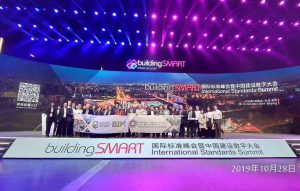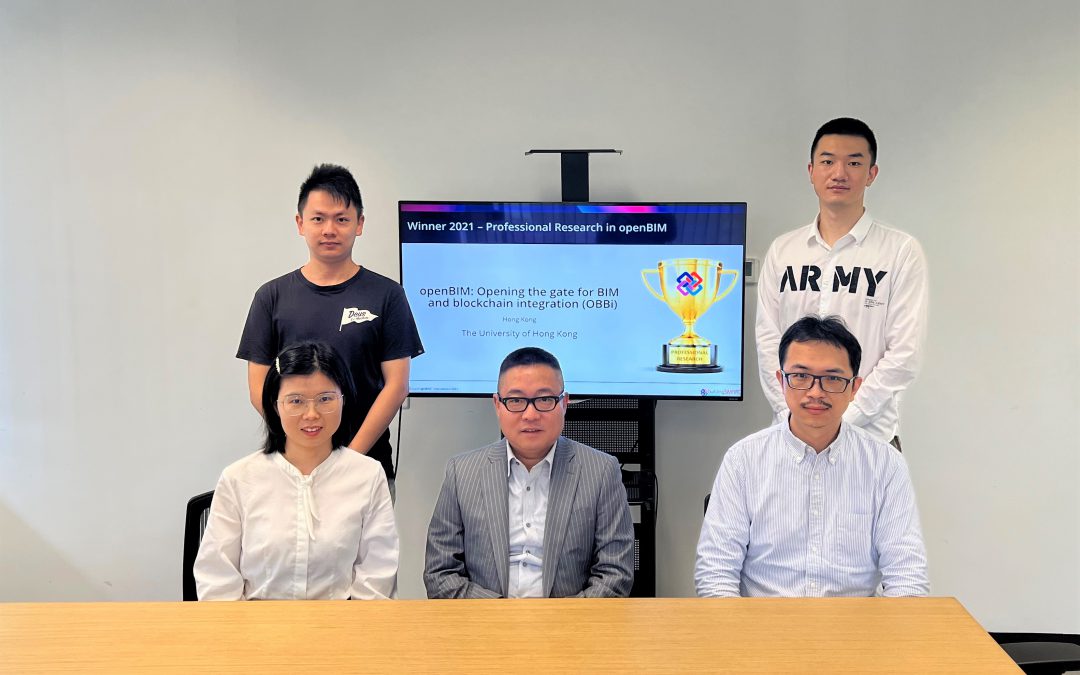[Good news from London on 7 October 2021] A team led by Professor Wilson Lu, Dr Frank Xue (Assistant Professor) and Dr Jinying Xu (Post-Doctoral Fellow) at iLab, Faculty of Architecture, The University of Hong Kong (HKU) won the buildingSMART International (bSI) Awards 2021 in the “Professional Research” category. Their project is called “OpenBIM: Opening the gate for BIM and blockchain integration (OBBi)”.

Figure 1. The winning team
(First row: From left to right, Dr Jinying Xu, Professor Wilson Lu, Dr Frank Xue; Second row: From left to right, Mr. Liupengfei Wu and Mr. Rui Zhao)
The bSI Award is a prestigious international award programme initiated since 2018 with an aim to promote OpenBIM for project design, construction, operation, research, and technology. In this year, there were 133 submissions entering the eight categories of the Award. The submissions were predominantly from developed, BIM-advanced countries/regions. A highly selective jury was formed to shortlist 3 finalists in each category, deliberating their presentations, and finally selecting a single winner from each category. The OBBi submitted by iLab is the sole winner in the Professional Research category. It is also the sole winner from Hong Kong across all the 24 finalists.
About the winning project – OBBi
The global architecture, engineering, and construction (AEC) community is exploring the benefits that can be instigated by Building Information Modelling (BIM) and blockchain integration. BIM is considered both a technology and process innovation to develop a digital representation of physical and functional characteristics of a facility (e.g., a building, a bridge, and so on) so it can serve as a reliable information basis for stakeholders to make decisions through the facility’s lifecycle. BIM is widely deemed the most disruptive development across the global AEC industry over the past two decades or so. Blockchain is known by many through Bitcoin. It is widely promoted for other uses due to its power of enhanced security, augmented traceability, increased efficiency, improved transparency, and reduced costs. According to the UK Institute of Civil Engineers (2018), BIM can take information from blockchain, e.g., material provenance, supply chain status, installation instructions, and contracts; and building information can be assigned to blockchain to be used later, e.g., for smart payment, procurement, traceability, or forensic investigation. However, there are three key obstacles:
- lack of interoperability between the existing commercial BIM software and blockchain;
- information redundancy if directly storing BIM in blockchain; and
- resemblance and swiftness of retrieving the information from blockchain and restore to BIM.
The iLab team developed an innovative idea to overcome the above obstacles. In a nutshell, the idea is to convert commercial BIM into OpenBIM in IFC (Industry Foundation Classes) format, calculate their changes (i.e., Semantic Differential Transaction, SDT), and put the small SDT file in blockchain; one can reserve the process to retrieve the information from blockchain and restore onto BIM. Four vital layers, including (1) Commercial BIM, (2) Web OpenBIM interface, (3) OpenBIM semantics-based server backend, and (4) Blockchain-based BIM data storage are designed for visualization, SDT records minimization and changes authenticity (See Figure 3). Particularly, the SDT model developed by the iLab team (Xue and Lu 2020) is able to differentiate the chronological changes and eliminates the information redundancy between IFC models using Python script compiled with the library of IFCOpenShell and IFCJson. With the OpenBIM blockchain and two Revit add-ons, the OBBi system can resolve the information authenticity and redundancy at the same time.

Figure 2. The solution of OpenBIM and Blockchain integration (OBBi)
The team piloted the OBBi in HKU Wong Chuk Hang modular integrated construction (MiC) Student Residence project. Integration of BIM and blockchain to track the provenance, production status, logistics status, and assembly status of construction materials, prefabricated components and MiC modules that are produced in Mainland China and then transported to Hong Kong construction sites for assembly. By integrating BIM in blockchain, stakeholders need not to worry about information tampering and quality disputes as the information in blockchain is guaranteed with authenticity and reliability. During the mock up process of this pilot project, the OBBi system demonstrates that BIM exchange and versioning using IFCJson -blockchain integration can be much faster and more reliable than traditional files. Moreover, OBBi demonstrates its power to re-connect the fragmented AEC processes in MiC projects that have been further exacerbated by the border restrictions resulting from COVID-19.
Three most innovative features of the OBBi:
- Tidying up the IFC for BIM and blockchain integration;
- Inventing an innovative methodology to blockchain BIM changes only; and
- Developing a novel approach to retrieve information from blockchain and restore it to BIM without time delay or information loss.
About the buildingSMART International
The buildingSMART International (bSI) is called the “international home of BIM”. BIM is widely recognised as the most important development in the global AEC industry over the past years. It is also highly promoted in Hong Kong, as evident in various Policy Addresses. Whilst BIM development has achieved unprecedented success, current BIM is too much tied up with profit-seeking vendors. The bSI is an open, vendor-neutral, and not-for-profit body pledged to promote OpenBIM by developing international standards to make BIM vendor neutral and more interoperable. The mission of bSI is to proactively support industry participants to develop open standards for planning, design, procurement, assembly and operation of buildings and infrastructure worldwide. It provides the international network plus the necessary technical and process support. Its members, who range from across the built environment spectrum, collaborate under the bSI organization. bSI is engaged with other international standards bodies such as ISO, the European Committee for Standardisation and the Open Geospatial Consortium. Its core IFC standards achieved ISO approval in 2012. The OpenBIM movement has made considerable success in many countries. Hong Kong is also playing an active role in bSI and this OpenBIM movement.

Figure 3. Hong Kong representatives at the buildingSMART International Summit in Beijing, 2019
Acknowledgement
The award is supported by an Innovation and Technology Fund: “BIM Square”: Blockchain and i-Core-enabled Multi-stakeholder Building Information Modelling Platform for Construction Logistics and Supply Chain Management in Hong Kong (ITP/029/20LP). The research team is also grateful that HKU Estate Office and Paul Y Engineering Ltd. provide the real-life project support. We also receive unfailing support from Hong Kong Construction Industry Council (CIC) and Hong Kong Alliance of Built Asset & Environment Information Management Association (HKABAEIMA) in this award and many other research endeavours in the iLab.


